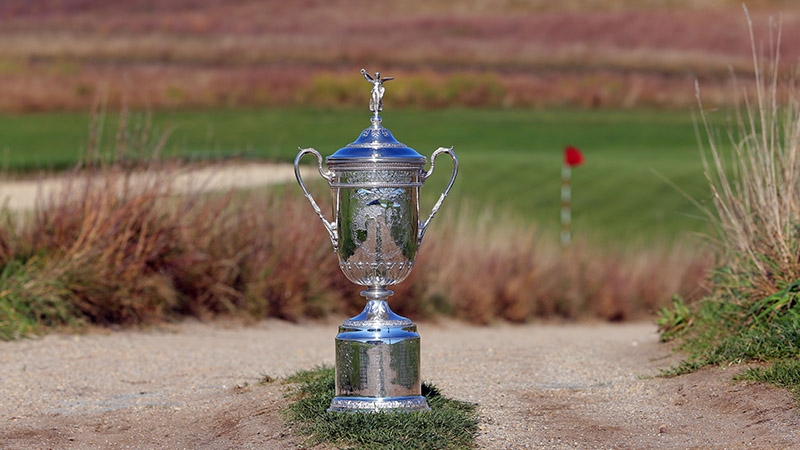Sobel: Bettors Can Take Advantage of the USGA’s Ongoing Identity Crisis
Brad Penner-USA TODAY Sports Pictured: Dustin Johnson (left to right) and Tiger Woods and Bryson DeChambeau
The Highlights
- The USGA is having trouble deciding whether it wants to appeal to players or fans when setting up U.S. Open courses.
- Wider fairways, light winds and today's technology should result in lower scores.
- Golf bettors can find value with over/under odds for the winning 72-hole score.
SOUTHAMPTON, N.Y. — The USGA has an image problem.
Think of the organization as a gawky teenager. The proverbial body is changing, the voice is getting deeper and yes, they’re self-conscious all the time.
For the USGA, it’s not about puberty, but other growing pains.
Fourteen years ago, here at Shinnecock Hills Golf Club and in direct contrast to a pussycat Olympia Fields the previous year, the greens baked out and, in the words of Phil Mickelson, the U.S. Open setup became “carnival golf.”
It recalled the words of former president Sandy Tatum, who presided over the 1974 “Massacre at Winged Foot", and said then, “Our intention is not to embarrass the greatest players in the world, but to identify them."
In recent years, the USGA has held the company line, but often acquiesced. Even Mike Davis, now the USGA executive director, recently admitted of the 2004 edition, “We probably made a bogey last time — maybe a double-bogey.”
Some of which is why we’ve seen a kinder, gentler USGA, much to the chagrin of golf fans who enjoy carnage with their Father’s Day brunch.
It’s not all the USGA’s fault.
Three years ago, it decided to take the U.S. Open to the Pacific Northwest for a change, moving it to brand new Chambers Bay. With the USGA overly cautious with its first-time setup of the course for this tournament, Jordan Spieth won with a score of 5-under — one of eight players to finish under par for the week. Last year, the organization opted for another new venue in Erin Hills; once again, it set it up with caution, and once again, the world’s best golfers ate it up, with winner Brooks Koepka posting a total of 16-under.
The USGA isn’t new to criticism, but it is new to the type of criticism it’s receiving now. Back in 2004, the cries were that officials acted unfairly toward the players. Now, the boo birds contend it’s become too easy.
It’s all led to an identity crisis for USGA executives.
They don’t know who they are or what they want to be. They want to please both players and fans. They want to serve as both the toughest test of golf all year, but not so tough that everyone complains about it.
What we’re left with is, just like any awkward teenager, the USGA doesn’t know how to act anymore.
The result is a Shinnecock course that is set up with fairways that are, in most cases, 20 to 30 yards wider than they were in 2004. At 7,445 yards, it’s long for a par-70, but Erin Hills was nearly 7,800 yards and we all saw how that turned out.
With winds expected to be 10 to 15 mph throughout the week — a one-to one-and-a-half club wind for most players — that might not be enough to keep the game’s best players from once again having a field day at the USGA’s expense.
The winning score of the last three U.S. Opens held at Shinnecock was 4-under (Retief Goosen, 2004), even-par (Corey Pavin, 1995) and 1-under (Raymond Floyd, 1986).
Here’s where we can use all of this information to our advantage.
Today’s elite golfers are bigger and stronger than ever before. Technology has turned each of them into a living, breathing Iron Byron, capable of hitting the ball wherever they want, whenever they want.
The point is, there’s nothing at this host venue that is going to scare these guys. They might not reach 16-under like last year, but with an over/under total of 275.5 for the winning score, it’s a smart play to assume the under. (For those wondering, 275.5 is 4.5-under par.)
Credit it to a combination of the talent in today’s game and the USGA’s ongoing identity crisis.
Even though officials want to set up the course more toughly than Erin Hills and Chambers Bay, they’re equally reticent to witness a repeat of that “carnival golf” here at Shinnecock.
Wide fairways, middling winds, increased technology and, perhaps most importantly of all, the USGA’s image problem should all converge to finish with a winning score easily within the red — and easily under the oddsmakers’ total.
How would you rate this article?





